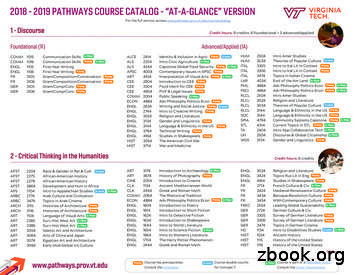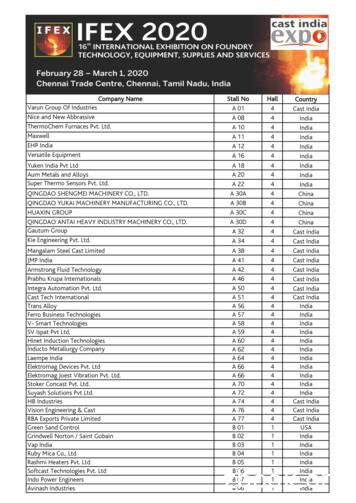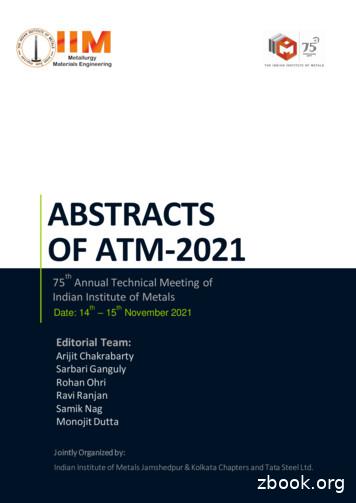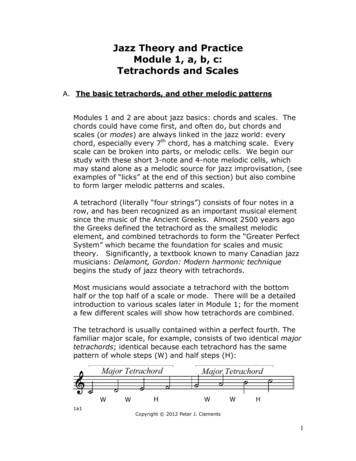Minor Hall - University Of Virginia
Minor HallSite-Specific Cleaning Program Standard Operating Procedure (SOP) ManualFebruary 2015"We provide services with your health, safety and the environment in mind."1 Page
About this ManualThis manual provides Standard Operating Procedures in place for cleaning the U.Va. building MinorHall. Together with individual procedures, it includes specific information that is unique to maintainingthe area and surfaces of this particular building, all with the primary purpose of cleaning spaceseffectively while protecting human health, the building materials and the environment.The procedures spelled out and referenced in this manual govern the following: cleaning protocolschemical handling and tracking requirementsequipment maintenance and operation procedurescommunication protocols and requirementstraining and inspection programsreporting and record keeping proceduresThese guidelines form the basis for training of our custodial staff in Minor Hall and a copy has beenprovided to the Facility Coordinator for the space. All occupants of Minor Hall may access and reviewthe manual at any time. As always, we encourage their input and ideas for improving our program.This manual and its procedures will be evaluated every summer for changes, updates andimprovements.2 Page
Our Green Cleaning Program PurposeAs stated on our business cards, our department’s purpose is to provide cleaning services with thehealth, safety and welfare of our building occupants, front-line workers and the environment in mind.By focusing on cleaning for ‘health’, we fulfill our objective of providing a learning and workingenvironment that is stimulating, creative and comfortable for our students, faculty, staff and guests.Minor HallCleanable square feet 16,936102 Amphitheater WayThe building houses approximately 55 occupants spread out over two floors. Unique to Minor Hall is alarge volume of lunch trash due to the food trucks, and cleaning challenges are presented by plants insome offices. University business conducted here includes:Carter Woodson Institute of African StudiesWoman, Gender, and SexualitySummer SessionThe Asian InstituteInternational StudiesNew Literary History3 Page
Table of ContentsAbout this ManualPage 2Our Green Cleaning Program PurposePage 3Table of ContentsPage 4Communications PlanPage 5Floor Maintenance PlanPage 7Cleaning StandardsPage 8Equipment Operation &Maintenance PlanPage 8Cleaning Inspection PlanPage 9Accident Preparedness PlanPage 9High Traffic Areas; Dining and Food Preparation Area; Laboratories and EntrywaysPage 11Storage and Use of ChemicalsPage 11Vulnerable PopulationsPage 11Special Requirements for Indoor Source of ContaminantsPage 12Special Requirements for Potentially Hazardous MaterialsPage 12Areas with Special Engineering ConcernsPage 12Seasonal or Periodic Conditions of Increased or Decreased VolumesPage 12Integrated Pest Control Management SystemPage 12Special Cleaning Requirements or ConditionsPage 124 Page
2.2.1 Communications Plan(See individual procedures and forms dealing with customer communication, including an annualsurvey, Customer Contact Tracking Form, Communication Flowchart, and Communication Strategy.)Purpose: Ensure that the Building Services cleaning program takes customer concerns, needs andrequirements into consideration as part of planning and executing on routine, periodic and restorativecleaning procedures.We are very committed to our customers and frequently solicit their feedback via surveys, emailcommunication and by identifying ‘value-added’ topics to prompt interaction and to help buildrelationships. We schedule one-on-one meetings with them regularly and at least once annually wemeet with them to debrief on customer satisfaction survey results (see sample document) and ourresponse.To ensure that customer requests and needs are responded to promptly, we direct them to call acentral Service Desk number (see separate communication flowchart) which always reaches ahuman being who forwards the request to the correct supervisor and manager.In addition, we are always thinking about opportunities to connect in meaningful ways with ourcustomers. An example of this is the Event Planning Form (see separate document) which wecreated to remind customers to include their Building Services team in planning for large events andto give us as much advance notice as possible so that we can staff accordingly. Creating such toolsto share with customers is another way that we add value and create opportunities to connect so thatwe understand our customers’ perception of our work and in turn that they understand the steps thatwe are taking to ensure their health and welfare remain our top priority.To track our customer connections, we use a simple Customer Contact Tracking Form (see separateform). This, too, gives us a structured opportunity to get in front of our key customers and solicit input,ideas, feedback, suggestions, complaints, compliments, etc., so that we remain on top of theirperception of our work. This form also permits us to capture conversation highlights so that we canfollow-up and provide complete responses to their concerns or comments. It also creates a nicerecord of progress and accomplishments that can be used during performance management seasonas we evaluate our front-line, supervisory and managerial team members.While the majority of interaction with customers occurs between supervisors and Facility Coordinators(FC), there is a customer service role for everyone to play, including front-line workers.The following provides some guidelines on the scope of customer-based communication as definedby cleaning program position:5 Page
Frontline Employees (FREM) - Greet building occupants daily and respond immediately torequests to provide service on matters such as spills, leaks, stock replenishment, emergencysituations or to give directions. As part of training, FREM are instructed on do’s and don’ts ofcustomer communication, including what constitutes providing too much or inappropriateinformation.Through our integrated suggestion program, Continuous Process Improvement (CPI), FREMare coached on the importance of bringing problems and their solutions to the attention of theirsupervisors. It’s through their observation and action that we can address issues at theirearliest point of occurrence and at the same time count on solutions that are grounded inreality and sustainability.Rewarding our FREM for jobs well done is a critical component to sustaining employeemotivation and engagement, which in turn helps improve the quality of our services. Eachquarter we honor top performers with a “This is How We Do It!” award certificate, includinglunch and prize drawings. Supervisors - will invite at least one face to face meeting with the FC weekly and stay in closecontact with customers to ensure we act as partners in planning for and executing onsuccessful events across Grounds.Managers - will have at least one face to face meeting, phone call or email communication withthe FC monthly and will interface with customers to announce major changes, improvementsor initiatives.Associate Director and/or Superintendent - will have at least one face to face meeting with theFC yearly and they encourage reaching out to them at any time for any reason.Customers – are directed to contact our service desk at (434) 924-1777 for all service requestsCustomers – are free to access the FREM for immediate assistanceFacility Coordinators: Twice annually we meet with all FC’s informal group settings where we present relevant information, updates and changes that impactthem and their buildings’ occupants.We also remind FC’s to continually assess for occupants who might be categorized as being part of a‘vulnerable population’ so that we can be aware of product, noise level or air quality issues to whichthey may be particularly sensitive, and adjust our operations accordingly. As an added resource forcustomers, they may visit our website, ces.html, toreview a variety of informational resources including our cleaning schedules, managers’ andsupervisors’ building assignments, contact information along with what’s new in our green cleaningtoolkit. Having said that, it is always our preference to provide answers to their questions andconcerns in personal meetings, by telephone or by email (in that order).6 Page
1.2.3.4.5.6.7.8.9.We know who our customers are.We know what our customers want.We believe that communication is the foundation for strong, long term relationships.We believe that it’s important to manage customer expectations so that we are all on the same page when itcomes to what is expected and what we deliver.We listen to our customers and act accordingly.We empower our staff to own and solve problems.We realize that details count and that sometimes the smallest things have the biggest impact.Training means improving and we take both seriously.We keep our finger on our customers’ pulse — how are they perceiving our services yesterday, today andtomorrow.Website: As an added resource for customers, they may visit our ingservices.html to review a variety of informational resourcesincluding our cleaning schedules, managers’ and supervisors’ building assignments, contact information alongwith what’s new in our green cleaning toolkit. Having said that, it is always our preference to provide answers totheir questions and concerns in personal meetings, by telephone or by email (in that order).2.2.2 Floor Maintenance PlanPurpose: Describe cleaning and maintenance procedures for all floor types located in Minor Hall sothat consistent with manufacturer recommendations, the life span of flooring is extended throughproper routine, periodic and restorative cleaning operations.(See separate procedures that address each of the floor types described below.)There are 5 types of flooring throughout Minor Hall:Wood, Carpet, Ceramic Tile, Rubber, and VCT Tile.1. Wood flooringWood flooring is located on the first floor. This is considered a public area which iscleaned as a high traffic area daily.2. Carpeting.Carpeting is located in most offices on the first and second floor. These carpets are cleanedon a weekly schedule and shampooed on an as needed basis.3. Ceramic TileCeramic tile is located on the first floor Men’s and Woman’s bathrooms. These areas areconsidered high traffic public spaces which are cleaned and maintained on a high traffic dailyand routine cleaning schedule.4. VCT TileVCT tile is located on the first and second floor’s office spaces, bathrooms and hallways. Thisarea is cleaned and maintained on a daily and routine cleaning schedule.7 Page
5. RubberRubber flooring is located on two sets of stairways from the first to second floor. This area is apublic space and is cleaned on a weekly schedule.2.2.3.1 – Routine Cleaning StandardOur goal is to clean to an APPA level 2. We will perform services at the frequency levels needed tomaintain a level “2”, based on traffic, special activity, weather and any other factors that impact thecondition of the space.Level 2---Ordinary TidinessThis is our target level. NOTE: Standards for restrooms, changing/locker rooms, etc. are the same as forLevel 1. Floors and base moldings shine and/or bright and clean. No buildup in corners or along walls, but there canbe up to two days’ worth of dirt, dust, stains, streaks. All vertical and horizontal surfaces are clean, but marks, dust, smudges, and fingerprints are noticeable withclose observation. Washroom and shower tile and fixtures gleam and are odor-free. Supplies are adequate. Trash containers are empty, clean and odor-free.2.2.3.2 Equipment Operation & Maintenance PlanPurpose: Describe our equipment operations and how we maintain it all(See detailed procedures on Powered, Battery and Non-Battery Powered Equipment)GeneralWe maintain the use of low-impact powered cleaning equipment and when equipment has exhaustedits lifespan, we replace it with equipment that reduces building contaminants and minimizesenvironmental impacts. As an example, when replacing equipment we look for models that requireless chemicals and water, produce 70 dbA of noise and which are ergonomically designed toprevent injury to workers. In addition, logs are maintained of all equipment specifications and actionstaken to ensure all is properly maintained and in good working order.Please see the Powered Equipment Manual for Building Services which lists equipment currently inuse at Minor Hall and any phase-out plans for non-compliance equipment.We have no propane-powered equipment in our inventory or in use.8 Page
2.2.3.3 Cleaning Inspections PlanA plan for conducting routine inspections to evaluate the effectiveness of the cleaning program, usingthe Association of Physical Plant Administrators (APPA) standards as a guide, is in place. TheUniversity’s target standard is a Level 2, and an electronic tool has been developed to facilitateinspections and capture data for use in reporting. Every month, a Quality Control Inspector conductsinspections of sample areas in all 100 buildings that we service. In addition, Supervisors, Managersand Senior Staff members will perform random inspections to ensure standards for cleaning are beingmet.Inspection results are sent electronically to Supervisors and Managers for follow-up and correctiveaction. Oversight of the quality control system is provided by the Associate Director andSuperintendent.Corrective actions include re-training, assessments and interviews with front-line staff. Areas that areear-marked for deficiencies by the inspection will be monitored by inspecting twice a month for sixmonths to ensure quality levels are maintained.Inspections are conducted daily by the supervisor and documented on an inspection form weekly perbuilding and managers conduct weekly inspections. (Please see separate procedure for more detailsand for a sample of the inspection tool.)2.2.3.4 Accident Preparedness PlanPurpose: Describe the steps needed to respond appropriately to emergencies and accidents.Evacuation Information:Follow Evacuation Plan posted in your housekeeping closet unless authorities are issuing differentinstructions. Generally speaking, evacuation is the plan of action for fire, bomb threat or other interiorcaused calamity. For this building, occupants are informed to exit and proceed to: the front side walkof the building facing the Amphitheater.9 Page
Shelter in Place:Find the lowest inner most part of the building away from glass and windows. Stay quiet and calm,pay attention to your surroundings and follow the directions of authorities.Fire:In this order: Activate the nearest fire alarm, exit the building (do not use elevators) and then call 911.Do not re-enter the building until authorized by the authorities.Tornado:Watch: Remain alert to weather conditionsWarning – You will have about 3 – 15 minutes to find the lowest inner most part of the building awayfrom glass and windows, i.e. hallways or basements; do not use elevators, close all doors, includingmain corridors, crouch near floor or under heavy, well-supported objects and cover you head, be alertof fire and go to the fire plan if needed.Earthquake:If you are outside stay outside, if you are inside, assess your surroundings to avoid falling throughfloor and ground openings, cover and crouch to avoid falling objects, try to find a secure place whileriding the shock waves.Explosion:Evacuate the building, do not use elevators, Call 911, if items are falling, crouch near floor or underheavy, well-supported objects and cover you head, be alert of fire stay low and go to the fire plan ifneeded, help other evacuate to the designated areas, if trapped try to tap on items that will alertpersonnel.Infrastructure Failure:All water, power, heat and cooling outages must be reported to the service desk at (434) 924-1777.Telephone outages must be reported to 434-924-8600 and any critical incident relating to computersystems call 434-924-3731.Hazardous Materials Release:There are no hazardous materials used or stored in Minor Hall. In the case that some are released inthis building: For a Major Spill - Call 911, evacuate to designated area, communicate with the FireDepartment, ALL other Spills – call (EHS) Environmental Health & Safety at (434) 982-4911 M – F,8am – 5pm and 911 during non-business hours.Suspicious Person:Do not let anyone into a locked building/office or “tailgate” into the building behind you, Do notconfront the person, Do not block the person’s exit, Do not pursue the person, Call 911 and provideas much information as possible10 P a g e
Suspicious Object:Do not touch or disturb the object, notify supervision and/or call 911, be prepared to evacuateViolent Incident:Escape if you can do it safely then call 911, if it is not safe to escape, seek protection, secure yourarea by locking or barricading yourself using whatever means available, stay behind solid objectsaway from door, call 911, minimize any noise that may draw attention to your location, turn off lights,computers, radios and put cell phones on silent or light vibrate, follow the directions of the authoritiesand do not challenge law enforcement.Inclement Weather:All weather types are handled through the office of the Operations & Maintenance Superintendent.They make the initial standby call to all Facilities Management Directors and Zone Managers. If theweather is calling for severe conditions only designated personnel are called in. Minor Hall has nodesignated employees and it is not an emergency designated rally site. In the event of snow, winds,and/or water Minor Hall will be closed until normal operations resume.2.2.4.1 High Traffic Areas; Dining and Food Preparation Areas; Laboratoriesand EntrywaysCleaning and maintaining high traffic areas, dining and food preparation areas and entryways isdiscussed in individual, separate procedures that address space type, location or material.2.2.4.2 Storage and Use of ChemicalsSeparate procedures and philosophies that address custodial closets spell out how chemicals are treated.There are two closets, one is located on the first floor and the second closet is located on the second floor.2.2.4.3 Vulnerable PopulationsWe have worked with Minor Hall’s Facility Coordinator to identify those who may be susceptible tochemicals being used as part of our service. As part of this assessment, we provide a list of chemicalbeing used with instructions on who to contact with questions or to advise us of any unique situations.Building occupants are encouraged to self-identify themselves so that we can manage the timing,frequencies, product choices or other aspects of providing services. In all cases, we attempt toschedule all services that may pose discomfort at times when building occupants are absent.11 P a g e
2.2.4.4 Special Requirements for Indoor Sources of ContaminantsConstruction---in the event of any renovations, the project manager will coordinate timing, location,level of disruption, harmful effects, if any, will communicate with Facility Coordinator and BuildingServices from design to completion.New Carpeting Installation---in the event of any new carpet installation, the maintenance zonemanager will coordinate timing, location, level of disruption, harmful effects, if any, with the FacilityCoordinator and Building Services from replacement assessment to completion.Special requirements for potentially hazardous materialsMinor Hall uses the floor maintenance program materials that are Ecologo approved. There are noasbestos concerns in Minor Hall.Bloodborne Pathogens (BBP)Do not touch nor clean up the spill that is assessed to meet the BBP requirements. Block off areawith wet floor signs; call your supervisor. See specific manual that addresses procedures forhandling BBP in great detail. Areas with Special Engineering ConcernsThere are no Special Engineering Concerns.Seasonal or Periodic Conditions of increased or decreased volumesThere is a steady stream of classes throughout the year, including summer sessions.Integrated Pest Control Management SystemPlans for managing pest populations inside buildings are maintained. The plan includes exterminationmethods, inspections and specifications of the circumstances under which pesticides are to beapplied. A communication plan provides advance notification of pesticide applications. Customersreport pest issues to the Facilities Management Service Desk who then issues a Work Order foroutside contractors to intervene. Such records are maintained electronically.Building Services uses contractors to perform pesticide applications and to take steps to manage andprevent pest recurrence. Such contractors are required to display proper signage in the areas beingtreated and we notify all building occupants of upcoming treatments which are performed when thebuilding is empty, whenever possible.Special Cleaning Requirements or ConditionsIn 2015, the only area that requires special cleaning consideration in Minor Hall is:- Indoor plantsSeparate procedures have been developed for maintaining indoor plants.12 P a g e
Our Green Cleaning Program Purpose As stated on our business cards, our department’s purpose is to provide cleaning services with the health, safety and welfare of our building occupants, front-line workers and the environment in mind. By focusing on cleaning for ‘health’, we
FSHD Thematic Minor Handbook 1 Thematic Minor Students majoring in FSHD have the option of declaring a thematic minor. The thematic minor is developed around a theme identified by the student, using courses from two or more disciplines. The major advisor must approve all thematic minors. The thematic minor must be 18 units, 9 of which must be .
ECON 4884 Adv Philosophy Politics Econ ENGL 2634 Writing and Social Justice . in Minor Course is part of a Pathways Minor. Consult the minor checksheets. in Minor in Minor in Minor in Minor in Minor . HIST 3554 Age of Globalization HIST 3564 The Cold War HIST 3864 Development and Hum in Africa
95 Neoairtec India Private Limited C 03 Refcoat Hall Hall 1 India 96 Susha Founders & Engineers C 04 Refcoat Hall Hall 1 India 97 Megatherm Induction Pvt Ltd C 05 Refcoat Hall Hall 1 India 98 Morganite Crucible India Ltd. C 08 Refcoat Hall Hall 1 India 99 Jianyuan Bentonite Co Lt
Raw Materials Industry 4.0 Products Non-Ferrous Metals Energy Advances in Materials Science Process Metallurgy Safety 16:15 - 19:30 hrs Raw Materials Industry 4.0 Products Non-Ferrous Metals Energy Advances in Materials Science Process Metallurgy Safety 15th NOVEMBER 2021 Time/ Hall Hall 1 Hall 2 Hall 3 Hall 4 Hall 5 Hall 6 Hall 7 Hall 8
FSHD Thematic Minor Handbook 1 Thematic Minor Students majoring in FSHD have the option of declaring a thematic minor. The thematic minor is developed around a theme identified by the student, using courses from two or more disciplines. The major advisor must approve all thematic minors. The thematic minor must be 18 units, 9 of which must be .
The pattern of whole steps and half steps in the minor tetrachord forms the lower half of the minor scale, and many similar scales: 1a2 When two minor tetrachords are joined, they form a dorian mode (or dorian scale), a scale that sounds very close to the natural minor scale: 1a3 The natural minor scale combines two tetrachords: a minor
The Minor 7th Chord The minor 7th chord is exactly the same as the minor chord. The only difference is one note, to create a minor 7th chord you add the 7th degree of the scale. In layman [s terms, the minor 7th chord is a more advanced version of the minor chord. Let [s learn this chord in ALL î
Chord Voicings C diminished (3 voicings) C augmented (3 voicings) Group A Scales (66 bpm) 1. Bb major 2. D major 3. G natural minor 4. B natural minor 5. G harmonic minor 6. B harmonic minor 7. Bb major pentatonic (right hand) 8. D major pentatonic (right hand) 9. G minor pentatonic (right hand) 10. B minor pentatonic (right hand) 11. C blues .























